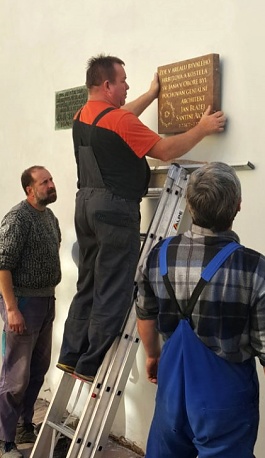
The famous architect Santini has a commemorative plaque in Prague
Prague - A memorial plaque for the architect Jan Blažej Santini, whose buildings significantly influenced the appearance of the Czech landscape and whose palaces in Prague are among the city's landmarks, was unveiled today in Hradčany. According to his wishes, Santini is buried in the now-defunct cemetery on Šporkova Street. The placement of the memorial plaque on the wall on Šporkova Street was initiated by the civic association Journey for Santini, and it was unveiled on the anniversary of his death.
photo: santini.cz
Afterward, a memorial mass was held at the Church of Our Lady of Divine Providence on Nerudova Street. The area around the plaque has been renovated, and the outline of Santini's most famous building - the church on Zelená Hora near Žďár nad Sázavou - has been planted in the sidewalk with cobblestones.
As the chairman of the association, Stanislav Růžička, stated today, all journeys to Santini's memorials can now end or begin at this plaque. Besides a written reminder of the architect, the stone square also features the outline of the Zelenohorský church engraved on it.
Czech architect of Italian descent Jan Blažej Santini Aichel (1677 to 1723) is known primarily for his interest in hidden symbols and his interpretation of Gothicizing Baroque. His projects, which combine deep knowledge of mathematics, geometry, numerology, fervor for Catholic doctrine, and the use of references from both Jewish and Christian mysticism, provide strong sensory and spiritual experiences.
During more than 20 years of his design work, he created nearly a hundred sacred, palace, and agricultural structures. He worked for numerous significant clients. He demonstrated a refined sense for integrating buildings into the landscape. He created and enhanced spaces with excellent acoustics and extraordinary lighting characteristics.
Among his most significant works, in addition to the aforementioned pilgrimage church listed as UNESCO heritage, are the monastery church of the Assumption of the Virgin Mary, St. Wolfgang, and St. Benedict in Kladruby in the Plzeň region, the convent of the monastery in Plasy, the pilgrimage church and Cistercian provostry in Mariánská Týnice, as well as the monastery church and ossuary in Sedlec near Kutná Hora.
Santini's buildings attract not only experts for examination but are also of public interest. The association Journey for Santini aims to popularize his work. Its members organize lectures, trips, and expeditions following the traces of Santini's life.
This spring, they published a comprehensive book that maps the individual chapters of Santini's life, his most significant buildings, and a list of all his authored works. The interest in Santini is evidenced by the fact that it has already been sold out. According to experts, Santini's work helps many understand the contradiction of Czech Baroque, where the supposed dark age is, in fact, a time of tangible flourishing of Czech construction, craft, and art.










